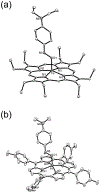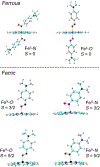Insight into the preferential N-binding versus O-binding of nitrosoarenes to ferrous and ferric heme centers
- PMID: 33634802
- PMCID: PMC8061117
- DOI: 10.1039/d0dt03604h
Insight into the preferential N-binding versus O-binding of nitrosoarenes to ferrous and ferric heme centers
Abstract
Nitrosoarenes (ArNOs) are toxic metabolic intermediates that bind to heme proteins to inhibit their functions. Although much of their biological functions involve coordination to the Fe centers of hemes, the factors that determine N-binding or O-binding of these ArNOs have not been determined. We utilize X-ray crystallography and density functional theory (DFT) analyses of new representative ferrous and ferric ArNO compounds to provide the first theoretical insight into preferential N-binding versus O-binding of ArNOs to hemes. Our X-ray structural results favored N-binding of ArNO to ferrous heme centers, and O-binding to ferric hemes. Results of the DFT calculations rationalize this preferential binding on the basis of the energies of associated spin-states, and reveal that the dominant stabilization forces in the observed ferrous N-coordination and ferric O-coordination are dπ-pπ* and dσ-pπ*, respectively. Our results provide, for the first time, an explanation why in situ oxidation of the ferrous-ArNO compound to its ferric state results in the observed subsequent dissociation of the ligand.
Conflict of interest statement
Conflicts of interest
“There are no conflicts to declare”.
Figures









Similar articles
-
X-ray absorption near edge studies of cytochrome P-450-CAM, chloroperoxidase, and myoglobin. Direct evidence for the electron releasing character of a cysteine thiolate proximal ligand.J Biol Chem. 1995 May 5;270(18):10544-50. doi: 10.1074/jbc.270.18.10544. J Biol Chem. 1995. PMID: 7737989
-
Electronic structure of six-coordinate iron(III)-porphyrin NO adducts: the elusive iron(III)-NO(radical) state and its influence on the properties of these complexes.J Am Chem Soc. 2008 Nov 19;130(46):15288-303. doi: 10.1021/ja801860u. Epub 2008 Oct 23. J Am Chem Soc. 2008. PMID: 18942830
-
Vibrational properties of heme-nitrosoalkane complexes in comparison with those of their HNO analogs, and reactivity studies towards nitric oxide and Lewis acids.Dalton Trans. 2024 Aug 20;53(33):13906-13924. doi: 10.1039/d4dt01632g. Dalton Trans. 2024. PMID: 39093017
-
Electronic structure of ferric heme nitrosyl complexes with thiolate coordination.Inorg Chem. 2007 Mar 5;46(5):1547-9. doi: 10.1021/ic070023f. Epub 2007 Feb 8. Inorg Chem. 2007. PMID: 17286401
-
Electronic structure of heme-nitrosyls and its significance for nitric oxide reactivity, sensing, transport, and toxicity in biological systems.Inorg Chem. 2010 Jul 19;49(14):6293-316. doi: 10.1021/ic902304a. Inorg Chem. 2010. PMID: 20666388 Review.
Cited by
-
Insights into Nitrosoalkane Binding to Myoglobin Provided by Crystallography of Wild-Type and Distal Pocket Mutant Derivatives.Biochemistry. 2023 Apr 18;62(8):1406-1419. doi: 10.1021/acs.biochem.2c00725. Epub 2023 Apr 3. Biochemistry. 2023. PMID: 37011611 Free PMC article.
References
-
- Kiese M, Arch. Exptl. Pathol. Pharmakol, 1959, 235, 360–364.. - PubMed
-
- Jung F, Biochem. Z, 1940, 305, 248–260. Chem. Abs. 235:472.
-
- Belisario MA, Pecce R, Garofalo A, Sannolo N and Malorni A, Toxicology, 1996, 108, 101–108. - PubMed
-
- Harrison JH and Jollow DJ, J. Pharmacol. Exp. Ther, 1986, 238, 1045–1054. - PubMed
-
- Roldan M, Perez-Reinado E, Castillo F and Moreno-Vivian C, FEMS Microbiol. Rev, 2008, 32, 474–500. - PubMed
MeSH terms
Substances
Grants and funding
LinkOut - more resources
Full Text Sources
Other Literature Sources

